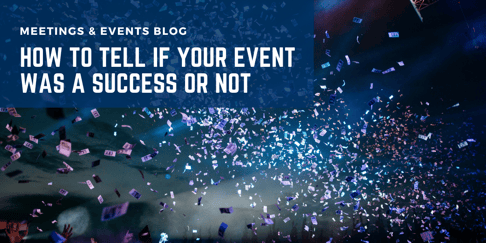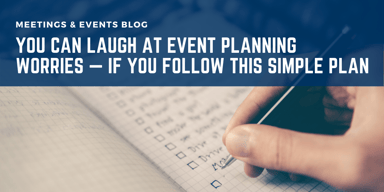
MeetingPackage
The fact that you have successfully hosted your big event doesn't mean you should sit back and relax! Regardless of whether you arranged a rare social event or a recurrent one, it's critical to comprehend what resonated- and the mistakes - with your occasion visitors.
Assessing event achievements is the initial step to take towards organizing your next occasion. The organization process of this current years' occasion is the place the assessment procedure starts. Past the desire for assessment from your chief and partners, knowing what worked, things that didn't, and where you can adjust, creates the foundation for progress and realizing what to measure against.
Pen down the Event Goals
Before you can get a precise appraisal of the occasion's success, you have to realize how to describe that achievement. Distinctive corporate occasions have various purposes. Is the objective of your event to gain new leads? Increase income? Make new business openings? When you distinguish the motivation behind your occasion, you would then be able to build up your objectives to assist you with defining the success of your event.
The objective of most organization events is usually about growing trivial things like organization culture, consumer loyalty, and worker happiness as well as collaboration and communication. If your participants are making some pleasant memories during the occasion, that can be sufficient to consider it a triumph.
The occasions that concentrate on customer effort and procurement, particularly in the B2B industry, regularly have increasingly substantial achievements of success. This makes them simpler to follow, inasmuch as you most likely are aware of how to catch the correct information from your event.
For example, coming up next is only a couple of primary occasion objectives and the fundamental sorts of information that occasion advertisers will follow:
Get New Leads — Lead generation software is a worthy investment for event organizers. There are currently news perks on this event software that permit you to effectively generate leads' by scanning a QR code from the participant's badge utilizing your telephone. However, we will advise that you make sure to try out the event management system ahead of time before your event.
Boost revenue — in case you're facilitating a fundraiser or charity event, you'll need to know the amount you have raised. To quantify this, basically subtract the expenses of the occasion (counting things such as time, work, nourishment, venue, and so forth.) from the income.
Building new connections — what's the amount it would cost you to get new clients? Utilize this as a benchmark to look at how your new clients acquired from your event measure up with your present clients. Ideally, you'll leave the occasion having gained progressively significant connections.
Whatever your objectives are, show them out and be as explicit as could be allowed so you will know whether the occasion accomplishes your goals.
Measure Income versus Overhead Expense
On the off chance that you hosted a corporate occasion, the reason for doing that is to promote brand recognition get and new clients. It's likewise about acquiring extra income – to profit from anything, however, you need to spend, and it's conceivable to pay more than you get if the occasion winds up below par.
You should quantify parameters like:
- Expected cost versus real expense
- Expected income versus real income
- Actual cost versus real income
Remember, however, that taking a look at the financial limit or potentially procuring marginally less income than likely doesn't consequently make the occasion a disappointment. You may, for instance, not have gotten as a lot of profit as envisioned however, acquired afar over an average number of signatures to be incorporated into your email list. That is scores of potential new customers, some of which might be long term clients that will do business with you for a long time to come.
Another perspective to gauge is the productivity in organizing your event. Did you invest an excess of energy in managing repetitive event logistics like getting ready to name identifications, event website updates, messaging back-end-forward to gather speakers' data, event promotion, and so on? To manage time and save money, think about how you can improve next time
Participation Measurements
One of the most straightforward measurements of success is the number of attendees to the event. The prevailing logic is straightforward: the more people you have, the better. While this way of thinking does not always apply to every corporate event, it is a good starting point for judging success.
When measuring attendance, be sure to track the check-in rates to calculate your expected attendee numbers. Unless the event has an open invitation, you will likely have a guest list or employee manifest. At the very least, the size of space and event preparations will have an assumed guest count. If the check-in rate is close to the expected attendee numbers, your pre-event marketing efforts were likely successful. Unfortunately, these numbers by themselves won’t tell you how successful the event itself is.
If your organization is holding an annual event, you should also consider measuring unique and repeat attendees. How many attendees at this year’s event came to your previous event? This data can be used as a benchmark for next year and help you estimate the number of attendees at your next event.
Analyze the Event
It’s also helpful to look at some necessary data from the event, as this will tell you whether or not you met goals for lead generation and customer engagement. Focus on how many participants came to the event, how many of them stayed for the entire event and how many of them actively engaged the presenters by asking questions or responding to what the event presenter said.
The engagement levels are particularly important because engaged participants are likely to get something out of the event and either uses your business or recommend it to others. From the perspective of generating leads and sales, high participant numbers with low engagement levels show it was not as successful an event as a lower participant number with high engagement.
Event Registrations and Live polls and quizzes analytics
One of the best and tested ways to measure the event success rate is with the live polls and quizzes. The amount of engagement live polls gets directly indicates the interest level of attendees and helps them to understand what session was most successful and had attendee’s attention in the live polls.
More so, the most sure-shot way to determine the event success rate is to look at the registration analytics. If the event organizer has planned to keep the registrations open for more than a month or so, they can even track the registration rate monthly and compare the sales periodically! There are various event registration and ticketing platforms that ease up the task of event organizers. Event ticketing analytics also gives you gross revenue the organizer is achieving with the sale of events tickets.
Evaluate Engagement
Engagement begins the moment you start to communicate with your audience, culminates onsite at the event, and should continue post-event. The more opportunities you create for attendee engagement, the better your odds of engagement success. Remember, attendees want a personal experience, and what is considered engaging for one attendee may not excite another. The value they see in your event is directly derived from their level of engagement – with each other, your content and your brand.
Greater engagement benefits everyone, and evaluating engagement should be a blend of the quantitative and qualitative data collected throughout the event life cycle. Engaged attendees are happy attendees. They typically rate an event higher on satisfaction surveys and are far more likely to attend each year. Interested attendees are naturally more participatory. Their increased participation benefits not only the event organizer but other attendees, exhibitors and sponsors. Below are three pillars on how you can evaluate engagement.
Keep Your Sponsors Happy with Plenty of Recognition and Ensure Attendee Retention
Sure, you had an excellent turnout for this event, but the trick is making sure folks come back in the future. Did people see the value in the event? Find inexpensive value adds that entice additional attendance without affecting your costs, and don’t forget that people expect recurring events to be bigger and better next year. Increase your partnerships with other organizations in the community that would be interested in advertising with you, or reach out to applicable local startups looking for ways to get their products out to the masses.
In addition to the above, sponsors can make or break your event so be sure they received adequate representation before, during and after the big day. The best way to guarantee sponsor retention is by ensuring the brand of your event aligns with that of the sponsors -- people will notice a disjointed pairing, like soda company banners at a vegan health food festival. Once you have a sponsor lineup that makes sense, be sure to sell sponsors on what they’ll receive for their investment, and help them feel engaged and excited about the impact they’ll make on the community by being part of your event.
Ask for Feedback
The best way to determine an event’s success is to get feedback from participants. If the participants enjoyed the event and got something out of it, the event was successful. If they did not, that’s a severe problem, because unsatisfied attendees won’t use your business or recommend it to their colleagues and friends.
Thus, the first step toward event evaluation is to ask for feedback. Many event holders provide attendees with a brief survey they can fill out after the event. To motivate participants to complete the study, many event holders offer an incentive for doing so, such entry into a drawing for a small prize.
In any case, the survey should include the following:
- What the participant thought of the event venue.
- What the participant think about the presentation(s) given during the event
- How valuable the content was to the participant.
- How likely the participant is to recommend similar.
- How likely the participant is to participate in similar events.
- A space for additional comments, suggestions, and feedback
By conducting this type of survey, you can find out what participants thought, felt, and experienced, and determine whether or not the event was a success from a customer service perspective.
Read also these blog posts:



